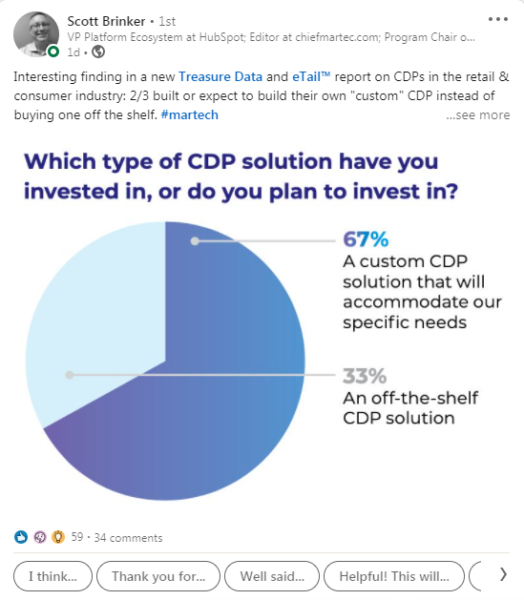What is broken that a CDP will fix?
What functionality would a CDP replace in your marketing stack?
The debate about CDPs — how to define them, whether they’re must-haves, and what they would replace in your existing stack — came roaring out of 2020 and will rage through 2021.
Just this morning, in our MarTech Today newsletter, we commented on the LinkedIn discussion sparked by this update from Scott Brinker:

Of course, one question immediately raised here, as marketing consultant Jordie Van Rijn pointed out, is “what a ‘custom’ CDP is.” NTE Growth Hacker Odd Morten Sørensen asked if building their own meant building “from scratch,” and Tealium CMO Heidi Bullock piled on by asking what “from scratch” meant.
We thought the finding was surprising: after all, it’s widely suggested that brands turn to CDPs once their own data storage or data lake projects overwhelm them — or at best, become repositories for data that can’t be actioned. CDP heavyweight Tasso Argyros of ActionIQ (who has some skin in the game) seemed to be thinking on the same track: “The high % of build vs buy is due to people defining CDP to mean a data lake with customer data in it. That is NOT a CDP. The CDP sits on top of data lakes and includes a wide array of functionality: from identity resolution to audiencing, journeys, orchestration, customer intelligence and much more.”
The discussion also recalled some heartfelt remarks by Williams-Sonoma marketing strategy and operations manager Pat Maigler in an episode of MarTech Live. Data lakes, Maigler emphasized, can be a robust and inexpensive way to store data: but they don’t provide the kind of actionable data marketers need. A data scientist or engineer becomes the intermediary, translating raw and unstructured data into insights which can drive engagement — but that’s a ponderous process and doesn’t support in-the-moment interactions with customers.
At a glance, that looks like a situation crying out for a CDP. But, says Maigler, marketers generally already have “their own purpose-built endpoint systems. I’m not sure that a lot of CDPs will replace the email engines that are being used. If you’re already using somebody like LiveRamp as an onboarder, and they’re syndicating to Google, Facebook, Pinterest and other partners, well — what do I really need?”
A CDP, Maigler says, needs to be web-based, non-technical, user-friendly and have pre-built connections to syndicate your data. “So if you have an onboarder, and you have existing pipes through Salesforce Marketing Cloud or Cheetah Digital, or any of these other providers, you don’t need to duplicate that functionality. Solve for your pain point or your opportunity.”
Watch Pat Maigler’s full remarks below, or the complete episode on managing the martech stack, with Maigler and Anita Brearton of CabinetM here.
Contributing authors are invited to create content for MarTech and are chosen for their expertise and contribution to the search community. Our contributors work under the oversight of the editorial staff and contributions are checked for quality and relevance to our readers. MarTech is owned by Semrush. Contributor was not asked to make any direct or indirect mentions of Semrush. The opinions they express are their own.
Related stories